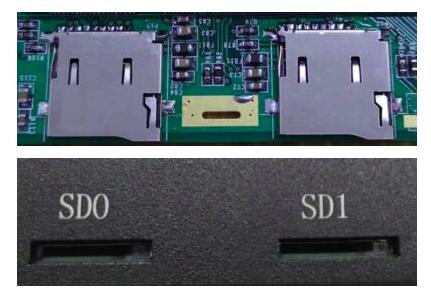EPC/PPC-CM3-101¶
Version 1.1




Product Overview¶
The Cortex®-A53 Raspberry Pi® series EPC/PPC-CM3-101 (PN: CS12800RA101) is a high-quality industrial Pi PC. It features a 10.1” five-point capacitive a touch screen with a resolution of 1280 x 800 pixels and brightness of 500 cd/m2.
It is available both as an embedded solution and as a device hosed in a casing with bezels, thus facilitating different installation options:
Installation on an industrial cabinet
Integration with the existing equipment
The EPC/PPC-CM3-101 industrial Pi PC is based around the powerful Raspberry Pi® Compute Module 3, powered by the BCM2837 processor with a processor speed of 1.2GHz and a 1GB RAM.
Ordering Options¶
Chipsee products can be customized during the ordering process. The product will be shipped with the pre-installed factory defaults if no extra requirements are specified. The table in the Specifications section provides information about the default options bundled with the product.
Note
You can order EPC/PPC-CM3-101 from the official Chipsee Store or from your nearest distributor.
Operating System¶
This product comes with a pre-installed Debian OS. Chipsee software engineers have created all the drivers, so every hardware feature is readily available for any standard development tool.
If your project requires a different OS, please Contact us, and we’ll make a customized version that suits your needs.
Optional Features¶
The EPC/PPC-CM3-101 industrial Pi PC does not include the 3G/4G/LTE modules by default. These modules are optional and can be selected at the Chipsee store during the ordering process.
Warning
Specifications¶
The EPC/PPC-CM3-101 industrial Pi PC offers a board range of performance and connectivity options for scalable integration, providing expandability according to future needs. Some of the key features are listed in the table below.
EPC/PPC-CM3-101 |
|
|---|---|
CPU |
Raspberry Pi® CM3, CM3 Lite; |
Storage |
2 TF Cards slots2 |
RAM |
1GB DDR |
eMMC |
8GB |
Display |
10.1” IPS LCD, 1280 x 800 resolution px, brightness 500 cd/m2 |
Touch |
5-point capacitive touch |
USB |
3 x USB 2.0 Host |
LAN |
1 x Channel 100M LAN |
Audio |
3.5mm Audio Out Connector, 2W Speaker Internal |
Buzzer |
Yes |
RTC |
Yes, High Accuracy RTC with Lithium Button Coin battery (lithium battery not included) |
RS232 |
4 x RS232 (1 debug port) |
RS485 |
2 x RS485 (Optional 4 x RS485 at most) |
CAN |
1 x CAN1 |
GPIO |
8 Channels, 4 Input, 4 Output |
WiFi/BT |
Onboard WiFi/BT |
HDMI |
1 Channel |
SATA II |
1 Channel |
3G/4G/LTE |
Supported, not mounted by default |
Camera |
Yes, not mounted by default |
Power Input |
From 6V to 36V |
Current at 12V |
700mA Max |
Power Consumption |
7W Typical |
Working Temperature |
From -20°C to +70°C |
OS |
Debian |
Dimensions |
CS12800RA101E: 245 x 155 x 11mm |
CS12800RA101P: 280 x 185 x 27.5mm |
|
Weight |
CS12800RA101E: 600g |
CS12800RA101P: 1500g |
|
- 1
The CAN channel may be customized to to 2 CAN channels on request.
- 2
Chipsee designed one of the TF card slots for Lite version but it does not have an eMMC. We designed the other one for storage expansion.
Attention
Chipsee does not install a lithium battery by default, as we cannot ship products with batteries. We recommend you buy it locally and install it by yourself. The lithium battery part number is CR1220. Please Contact us if you need help.
Power Input¶
The EPC/PPC-CM3-101 industrial Pi PC can be powered by a wide range of input voltages: From 6V to 36V DC. There are two types of power input connectors. One is a 3 Pin, 3.81mm screw terminal connector, and the other is a 2.1mm DC input head. The polarity and the pinout is clearly marked on the housing of the CS12800RA101P version, as well as on the board itself of the CS12800RA101E version, as shown in the figures below.

Figure 1020: Power Input (embedded/enclosed version)¶
Note that the “+” sign represents the positive power input, and it is printed both at the casing and as a silk-screen on the board of the embedded version. The “-” terminal is shorted to the ground.
Power Input Definition |
||
|---|---|---|
Pin Number |
Definition |
Description |
Pin 1 |
Positive Input |
DC Power Positive Terminal |
Pin 2 |
Negative Input |
DC Power Negative Terminal |
Pin 3 |
Ground |
Power System Ground |
Note
The system ground “G” is connected to power negative “-” on board.
The central pin is positive.
Touch Screen¶
The EPC/PPC-CM3-101 industrial Pi PC uses a 5-point capacitive touch screen. The figure below shows the capacitive touch screen connected to the motherboard via the FPC connector.

Figure 1021: Capacitive Touch Connector¶
Attention
A capacitive touch screen is susceptible to power noise and Electromagnetic Radiation (EMR). It may cause LCD ripples or even capacitive touch malfunction. If using a capacitive multi-touch test application, you might notice the touch points float erratically across the display. There are several solutions to this problem:
Use a high-quality Power Adapter Unit (PSU) with low EMR. You can also provide power from a battery.
Make sure that the EPC/PPC-CM3-101 Power Input connector (pin 3) is properly connected to the Power System Ground to provide sufficient EMI shielding and eliminate the problem entirely.
Bad GND problem can also be confirmed by touching pin 3 of the Power Input connector with one hand while operating the capacitive touch screen with the other hand. In this case, the operator’s body acts as the Power System Ground.
Connectivity¶
There are many connectivity options available on the EPC/PPC-CM3-101 industrial Pi PC. It has 3 x USB 2.0 Host (can be customized to Host or OTG), 1 x Channel 100M LAN (RJ45) Ethernet connector supporting up to 1 Gbps, and 5 x UART terminals (RS232/RS485).
RS232/RS485/CAN¶
The serial communication interfaces (RS485, RS232, and CAN) are routed to a 16-pin 3.81mm terminal, as illustrated on the figure below.

Figure 1022: Relation between serial pins on embedded vs. enclosed version of the EPC/PPC-CM3-101 Industrial PC¶
The table below offers more detailed description of every pin and its definition:
RS232 / RS485 / CAN Pin Definition: |
||
|---|---|---|
Pin Number |
Definition |
Description |
Pin 1 |
CAN1_L |
USB CAN Channel 1L signal |
Pin 2 |
CAN1_H |
USB CAN Channel 1H signal |
Pin 3 |
RS485_4+ |
USB UART4, RS485 +(A) signal |
Pin 4 |
RS485_4- |
USB UART4, RS485 -(B) signal |
Pin 5 |
RS485_3+ |
USB UART3, RS485 +(A) signal |
Pin 6 |
RS485_3- |
USB UART3, RS485 -(B) signal |
Pin 7 |
RS232_2_RXD |
USB UART2, RS232 RXD signal |
Pin 8 |
RS232_2_TXD |
USB UART2, RS232 TXD signal |
Pin 9 |
RS232_1_RXD |
USB UART1, RS232 RXD signal |
Pin 10 |
RS232_1_TXD |
USB UART1, RS232 TXD signal |
Pin 11 |
CPU_RS232_1_RXD |
CPU UART1, CPU RS232 RXD signal |
Pin 12 |
CPU_RS232_1_TXD |
CPU UART1, CPU RS232 TXD signal |
Pin 13 |
CPU_RS232_0_RXD |
CPU UART0, CPU RS232 RXD signal |
Pin 14 |
CPU_RS232_0_TXD |
CPU UART0, CPU RS232 TXD signal |
Pin 15 |
GND |
System Ground |
Pin 16 |
+5V |
System +5V Power Output, No more than 1A Current output |
GPIO Port¶
The EPC/PPC-CM3-101 industrial Pi PC has a 10 Pin 3.81mm GPIO Connector, as shown on the figure below. The table below gives details about the definition of every Pin.

Figure 1023: GPIO Connector¶

Isolated GPIO reduced schematic
GPIO Connector Pin Definition: |
||
|---|---|---|
Pin Number |
Definition |
Description |
Pin 10 |
VCC |
Isolated Power +5V Input |
Pin 9 |
GND |
Isolated Ground |
Pin 8 |
OUT1 |
Isolated Output 1 |
Pin 7 |
OUT2 |
Isolated Output 2 |
Pin 6 |
OUT3 |
Isolated Output 3 |
Pin 5 |
OUT4 |
Isolated Output 4 |
Pin 4 |
IN1 |
Isolated Input 1 |
Pin 3 |
IN2 |
Isolated Input 2 |
Pin 2 |
IN3 |
Isolated Input 3 |
Pin 1 |
IN4 |
Isolated Input 4 |
Attention
The GPIO has been Opt-Isolated and it uses the 5V Logic by default. You can use an external isolated power input but the power input range should be from 5V to 24V DC.
The 4 output channels can drive at most 500mA current on each channel.
USB Connectors¶
There are 3 x Type A USB HOST connectors onboard, as shown on the figure below.

Figure 1024: USB HOST Connectors (embedded/enclosed PC version)¶
The product has one USB OTG connector that works as a slave by default. You can use it to establish a connection with the host PC and for downloading the system to the eMMC of CM3/CM3+.

Figure 1025: USB OTG Connector¶
Warning
Be careful not to touch surrounding electronic components accidentally while plugging in USB devices into the embedded Industrial PC version.
LAN Connectors¶
LAN (RJ45) connector provides Ethernet connectivity over standardized Ethernet cables as shown the figure below. The integrated Ethernet interface supports up to 1 Gbps data throughput.

Figure 1026: RJ45 LAN Connectors (embedded/enclosed PC version)¶
Note
Use CAT5 or better cables to achieve full data throughput over maximum distance defined by the 1000BASE-T standard (100m).
WiFi & BT Module¶
The EPC/PPC-CM3-101 industrial Pi PC is equipped with the popular Realtek RTL8723 WiFi/BT module that supports BT/BLE 4.0 (with backward compatibility), as well as 802.11bgn 2.4 GHz Wireless LAN (WLAN).

Figure 1027: RTL8273 WiFi/BT Module¶
The enclosed (CS12800RA101P) variant of the product also includes an SMA connector for an external WiFi/BT antenna, as illustrated in the figure below.

Figure 1028: WiFi+BT Antenna¶
3G/4G/LTE Module¶
The EPC/PPC-CM3-101 industrial Pi PC is equipped with a mini-PCIe connector that can connect to a 3G/4G module. The customer will also need a SIM Card Holder and a 3G/4G Antenna Connector to ensure 3G/4G works on the EPC/PPC-CM3-101.

Figure 1029: 3G/4G Module¶

Figure 1030: SIM Card Holder and 3G/4G Antenna Connector¶
Attention
The product does not come shipped with the 3G/4G module by default.
TF Card Slot¶
The EPC/PPC-CM3-101 industrial Pi PC features 2 x TF Card (micro SD) slot: SD0 and SD1. Both slots can address up to 32GB of memory.
The SD0 is used only for the Lite version of Compute Module that has no internal eMMC. The SD1 is used for external storage.

Figure 1031: TF (micro SD) Card Slot¶
Note
The product does not come shipped with the TF Card by default.
Audio Connectors¶
The EPC/PPC-CM3-101 industrial Pi PC features some audio peripherals. It has 1 x 3.5mm audio output jack.
Also, the EPC/PPC-CM3-101 industrial Pi PC has a miniature 2W internal speaker for audio reproduction, as well as a small buzzer for alarm/notification sounds.

Figure 1032: Audio Connector (embedded/enclosed PC version)¶
Boot DIP Switch¶
The EPC/PPC-CM3-101 industrial Pi PC has one switch on the board marked as SW1, shown in the figure below. It has two positions USB and eMMC.
When switch is in the USB position, the Raspberry Pi will boot from the USB connector. You can use this function to download the OS software to the internal eMMC.
When switch is in the eMMC position, the Raspberry Pi will boot from internal eMMC.
There is no need to alter the DIP switch settings during regular operation. However, if you need to reinstall the OS, please refer to the detailed information on how to re-flash the OS from the Software Documentation.

Figure 1033: Boot DIP Switch¶
Mounting Procedure¶
The EPC/PPC-CM3-101 industrial Pi PC can be mounted with 4 x M4 screws, enabling simplified installation onto any standard mounting fixture.
CS12800RA101E¶
You can mount CS12800RA101E with the Embedded mounting method, as shown on the figure below.

Figure 1034: Embedded mounting¶
CS12800RA101P¶
You can mount CS12800RA101P with the Vesa (75 x 75mm) and Panel mounting methods, as shown on the figure below.

Figure 1035: Panel mounting¶
Attention
Please make sure the display is not exposed to high pressure when mounting into an enclosure.
You can find detailed information about mounting in the Mount IPC Guide.
Mechanical Specifications¶
CS12800RA101E¶
The outer mechanical dimensions of CS12800RA101E are 245 x 155 x 11mm (W x L x H). Please refer to the technical drawing in the figure below for details related to the specific product measurements.

Figure 1036: CS12800RA101E Technical Drawing¶
CS12800RA101P¶
For CS12800RA101P, the outer mechanical dimensions are 280 x 185 x 27.5mm (W x L x H). Please refer to the technical drawing in the figure below for details related to the specific product measurements.

Figure 1037: CS12800RA101P Technical Drawing¶
Disclaimer¶
This document is provided strictly for informational purposes. Its contents are subject to change without notice. Chipsee assumes no responsibility for any errors that may occur in this document. Furthermore, Chipsee reserves the right to alter the hardware, software, and/or specifications set forth herein at any time without prior notice and undertakes no obligation to update the information contained in this document.
While every effort has been made to ensure the accuracy of the information contained herein, this document is not guaranteed to be error-free. Further, it does not offer any warranties or conditions, whether expressed orally or implied in law, including implied warranties and conditions of merchantability or fitness for a particular purpose. We specifically disclaim any liability with respect to this document, and no contractual obligations are formed either directly or indirectly by this document.
Despite our best efforts to maintain the accuracy of the information in this document, we assume no responsibility for errors or omissions, nor for damages resulting from the use of the information herein. Please note that Chipsee products are not authorized for use as critical components in life support devices or systems.
Technical Support¶
If you encounter any difficulties or have questions related to this document, we encourage you to refer to our other documentation for potential solutions. If you cannot find the solution you’re looking for, feel free to contact us. Please email Chipsee Technical Support at support@chipsee.com, providing all relevant information. We value your queries and suggestions and are committed to providing you with the assistance you require.